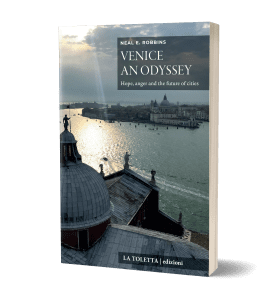An evocative, engaging and perceptive portrait of Venice, Italy — the ultimate city, a place with stories on every street and in every doorway, nook and cranny.
An evocative, engaging and perceptive portrait of Venice, Italy — the ultimate city, a place with stories on every street and in every doorway, nook and cranny.
An evocative, engaging and perceptive portrait of Venice, Italy — the ultimate city, a place with stories on every street and in every doorway, nook and cranny.

PRAISE FOR VENICE, AN ODYSSEY
GIORGIO CROVATO, historian and a director of Ateneo Veneto, the foremost cultural institution of Venice, describes Venice, an Odyssey:
“Nonfiction essay? A guide? A historical text? An autobiographical story? There’s a bit of everything in this accurate, interesting, original work created by a writer who has… worked and studied all over the world. As an adolescent Neal E. Robbins attended high school in the city for a year… hosted by a [Venetian family] that after 50 years later he still considers his own… an American who became Venetian….
[He] is the Venetian Ulysses, and he gives everyone the chance to better understand this special city from the Venetian viewpoint.… Neal took to the lagoon in a typical Venetian boat… in the 1970s when the city was living perhaps its last moments of normality before the uncontrolled invasion of tourists…
[He returned half a century later] as a journalist-historian [who] magnificently brings these …professions together, keeping in mind his objective of “unraveling the enigma that is Venice,” … and bringing in a fundamental element: passion. He continually involves the inhabitants of… the historic city and on the islands, people from all walks of life and every cultural level, his old school companions, respected scholars of Venetian history and writers of past and present.
With wisdom and judiciousness, Neal confronts the fundamental themes — historical, environmental and social — seeking to overcome cliches, invented traditions, and prejudices…. The 28 chapters and 11 intermezzos focus on the extraordinary contributions of the 150 Venetians in the account that succinctly sums up… the elements of a modern community: Culture, economics and politics… all united by a hope that… Venice continues to enlighten the hearts of everyone.”
The world heritage city has fostered creativity in generations of artists, artisans and authors. It has a rich culture and intriguing history. It also faces formidable challenges — a fragile ecosystem, rapid depopulation and political volatility — raising fears that the city will end up as an inauthentic museum for tourists.

Venice, an Odyssey — The chapters
What is it about Venice?
The world heritage city has fostered creativity in generations of artists, artisans and authors. It has a rich culture and intriguing history. It also faces formidable challenges — a fragile ecosystem, rapid depopulation and political volatility — raising fears that the city will end up as an inauthentic museum for tourists.
Neal E. Robbins reexamines this endangered metropolis, reflecting on the changes he has seen since he first encountered it in the early 1970s when he lived there with a Venetian family as a high school senior. After a gap of nearly 50 years and an international career as a journalist, he returned to see how the city has endured and changed.
Drawing on his perspectives as a foreign correspondent, Robbins brings rigorous research, curiosity and keen insights to his personal experiences of Venice, delivering a multidimensional picture of this unique place. Taking the reader down the maze-like streets, into family homes and on to boats plying its canals and vast lagoon, Robbins vividly recounts the city’s incredible past and explains its present-day political struggles, car-free lifestyle and battles with acqua alta flooding. He draws on over 150 exclusive interviews with Venetians from all walks of life — boat builders, medieval historians, an ornithologist, a retired bank worker, novelists, a psychoanalyst, climate scientists, funeral directors, noblemen and a former pop star — to describe Venice as it was, as it is now and what its future may hold.
Readers will come away with a deeper understanding of Venice, the threats it faces and what it shows us all as a key bellwether of forces driving global change.

